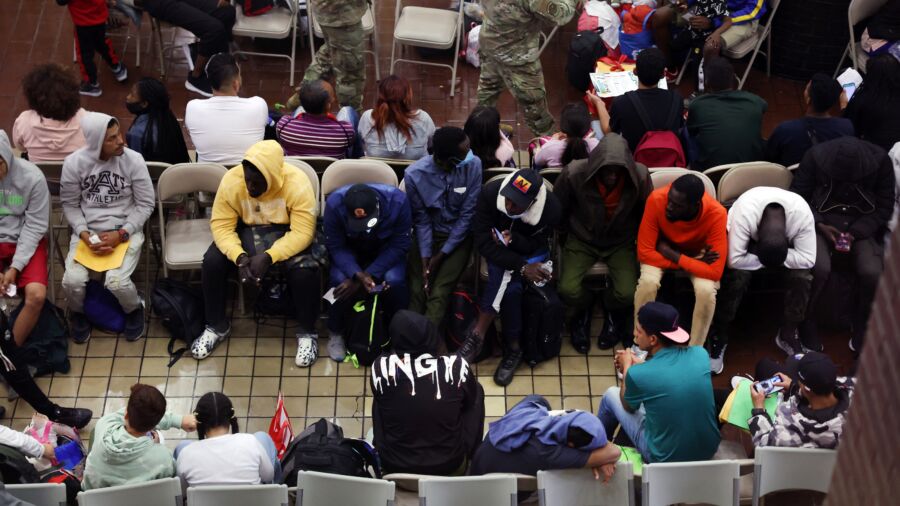Republican Mayor of Miami Francis Suarez praised his Democratic New York City counterpart, Mayor Eric Adams, for being outspoken on how the influx of illegal immigrants is impacting Adams’s jurisdiction.
“I’m actually quite proud of Mayor Adams from New York for standing up and talking about how this is impacting the city of New York,” Suarez said in an interview with CBS News’s “Face The Nation” on Sunday. “I mean, he has to focus on crime reduction and instead, you know, you see images of police officers helping people in the classic Roosevelt Hotel find housing. And so, you know, these officers should be—and you’d want them to be—focused on reducing crime and instead, have to deal with this migrant crisis which, as you’ve said, should be a federal issue.”
Earlier this month, Adams said President Joe Biden’s administration bears some of the responsibility for his city’s struggles in dealing with incoming illegal immigrants.
Adams appeared on the same Sunday CBS News program just minutes before Suarez, where he discussed the impact U.S. immigration policies have had on New York City.
“You said that the president and the White House have failed New York City and that you don’t have access to federal dollars to deal with the migrant crisis, but the administration reportedly has pledged $30 million to deal with those arrivals. Why the discrepancy?” CBS host Margaret Brennan asked Adams.
“I don’t think that’s a discrepancy. We’ve spent over a billion dollars,” Adams replied. “We’re projected to spend close to $4.3 billion, if not more. This estimate was based on a number of migrants coming to the city, and those numbers have clearly increased. We received, in several days last week alone, over 900 migrants on days … over two weeks ago, approximately 4,200 in one week. When you look at the price tag, $30 million comes nowhere near what this city is paying for a national problem.”
While Adams said New York City has received $30 million in federal support for this particular issue, Suarez told Brennan he’s not aware of any federal support for Miami.
“We checked to see if we had gotten any help from FEMA, it turns out we have not,” Suarez said. “It is a migrant crisis in our city as well. Just in the last two months, the Coast Guard has processed 408 migrants on our coast. Just last year in our public school system, we had over 14,000 new children, 10,000 of which came from four countries: Cuba, Nicaragua, Venezuela, and Haiti. And that’s the equivalent of five new 2000-student schools. And that’s a tremendous burden on our system.”
Other Cities, Towns Should Share Illegal Immigrant Burden: Adams
Part of the reason New York City is seeing so many new illegal immigrants is that Republican Texas Gov. Greg Abbott has been bussing illegal border crossers—who have been released from federal custody into the United States—from Texas border communities to other parts of the country. Abbott’s bussing strategy has sent these illegal immigrants to so-called “sanctuary cities,” which do not cooperate with federal immigration authorities that might arrest or deport illegal immigrants. New York City is one such self-declared “sanctuary city” targeted in Abbott’s bussing strategy.
Adams has criticized this bussing program and has tried to start his own “decompression strategy” of sending illegal immigrants from New York City to neighboring areas of New York State.
Abbott has said his bussing strategy has shone a spotlight on the hypocrisy of sanctuary cities that balk at the prospect of having to actually take, and share responsibility for, illegal immigrants.
On Sunday, Adams told CBS that he’d prefer to see the burden of sheltering and caring for illegal border crossers dispersed more evenly throughout the country.
“We have 108,000 cities, villages, towns. If everyone takes a small portion of that and if it’s coordinated at the border to ensure that those who are coming here, to this country, in a lawful manner [are] actually moved throughout the entire country, it is not a burden on one city,” Adams said.
“We received over 70,000 migrant asylum seekers in our city: 42,000 are still in our care. If this is properly handled at the border level, this issue can be resolved while we finally get Congress, particularly the Republican Party, to deal with a comprehensive immigration policy,” he added.
Title 42’s End
Federal, state and local officials have been preparing for months in anticipation of the end of Title 42—a pandemic-era authority that allowed border officials to turn away and expel migrants from the United States for public health reasons.
Prior to the end of Title 42, the Biden administration implemented a travel policy (pdf) similar to one seen under President Donald Trump, which disqualifies immigrants from applying for asylum in the United States if they didn’t first seek protection in countries they passed through on their way to the United States. The Biden administration has also developed a parole program that allows immigrants to enter and work in the United States for up to two years. The Biden-era rules state that those who still ignore the border and cross illegally will be expelled and disqualified from future entry under the parole program.
Some officials had anticipated that the expiration of the Title 42 authority would lead to a surge in traffic at the U.S. border. According to the U.S. Department of Homeland Security (DHS), the number of migrants encountered at the southern border fell by about 50 percent in the first three days after Title 42 expired compared to the traffic in the days leading up to the end of the policy.
Last week, DHS Assistant Secretary for Border and Immigration Policy Blas Nunez-Neto said it’s “still too early to draw firm conclusions” about post-Title 42 immigration and border security trends.

